Nanda Devi Raj Jat Yatra 2026 – A Sacred Himalayan Pilgrimage
– Mohit Bangari
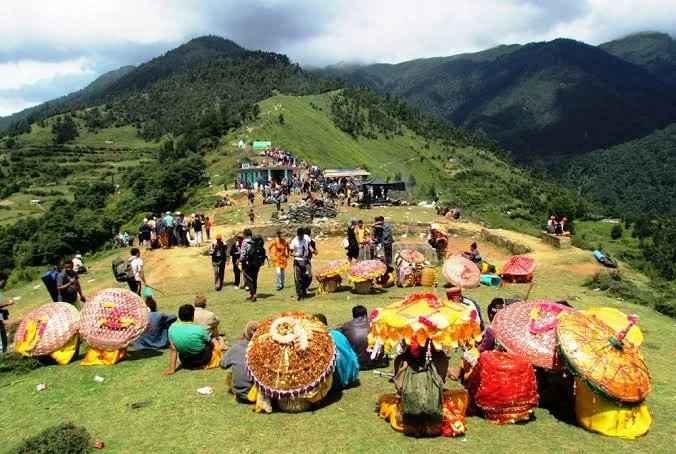
Table of Contents
Nanda Devi Raj Jat
Nanda Devi is known as the main goddess of the central Himalaya. As per the old belief, after the death of Lord Shiva’s first wife, Sati, she took birth again as Nanda. She was born in the royal family of the ancient Rinsasain (Rishasain) state, at the home of Himwan Rishi and his wife Menawati .
People believe that after her marriage, her family and people from her maiti side (maternal side) did not call her back home for 12 years. Nanda Devi felt very hurt and angry. She even cursed her maiti for forgetting her. Then, to make her happy, the people of her Maiti side called her back home after 12 years. Local folk songs and stories also says that his two brothers, Hit and Binser went to Kailash and called her.
After visiting her maiti, when Nanda Devi went back to Kailash, her people from maiti side walked with her till Kailash to bid her farewell. The Nanda Devi Raj Jat Yatra shows this same emotional farewell journey.
In this yatra, Nanda Devi’s people from the maiti side take her to Kailash with love and devotion. They carry sagun (gifts) and blessings for her. A very special part of this yatra is a four-horned ram (char sing wala mendha), who walks in the front. This ram plays an important role in the whole journey.
The yatra starts from Nauti and Kansuwa villages and goes through Koti, Kulsari, Tharali, Mundoli, Wan, and Bedini before reaching Homkund, which is near Roopkund. At Homkund, the yatra ends. The return route comes back through Sutol, Ghat, and Nandprayag. Local people also called this yatra Thulli jat or Badi Jat. In Kurud Village an annual jat is also organised, which goes to Bedni and ends there. This jat is called Malli Jat or Choti Jat.
This sacred yatra takes place once every 12 years. It is not only a religious journey but also a cultural symbol of the Garhwal Himalaya.
For the complete story, legends, and all detailed information about Nanda Devi Raj Jat, I have already written a separate full article. You can read that here:
Nanda Devi Raj Jat Yatra – Full Story and Complete Details
Nanda Devi Raj Jat Yatra 2026 Preparations
The next grand Nanda Devi Raj Jat Yatra will be held in 2026. This centuries-old pilgrimage happens only once in 12 years. The exact date of the yatra will be declared closer to the event, but as per tradition, it usually starts in the monsoon season, between August and September, according to the Hindu calendar.
Right now, preparations for the Nanda Devi Raj Jat Yatra 2026 have already begun at the government and local committee level. Recently, the Nanda Devi Raj Jat Yatra Samiti members, led by its chairman Dr. Rakesh Kunwar, met Uttarakhand Chief Minister Pushkar Singh Dhami at the CM residence. They discussed different points related to the smooth and grand organisation of this upcoming yatra.
The Chief Minister has given instructions to senior officers to prepare a complete and well-planned roadmap. All main arrangements must be finished by the end of 2025. This early preparation will help to manage the large number of pilgrims and visitors who will take part in the Nanda Devi Raj Jat Yatra 2026.
CM Dhami also said that this Nanda Devi Raj Jat Yatra represents the rich cultural and spiritual traditions of Uttarakhand. So, the government is planning to organise it in a more grand way this time. All departments have been told to work together in coordination. Efforts will also be made to connect local folk artists, gram panchayats, and volunteer groups with this event.
On the ground level, the Nanda Devi Raj Jat Yatra Samiti has also started visiting different halting places of the yatra route in Pindar valley. The committee members have gone to Dewal, Tharali, Narayanbagad, and Karnprayag blocks to check the present facilities and note down the problems. They are also taking feedback from local villagers to plan for food, shelter, sanitation, and security arrangements for the coming Nanda Devi Raj Jat Yatra.
These early efforts clearly show that both the government and the committee want to make the Nanda Devi Raj Jat Yatra 2026 a safe, well-managed, and memorable event for everyone.
At the district level, Chamoli’s District Magistrate Dr. Sandeep Tiwari chaired a key meeting. He directed all departments and gave clear responsibilities. The yatra route is long — nearly 280 km in total. Out of this, about 207 km is on foot and about 73 km is covered by vehicles. On the return journey roughly 60 km will be by vehicle.
Security is a top priority. The DM asked SP Sarvesh Panwar to arrange police deployment. He also asked for district-level training of security staff. Further, the police will plan crowd-control, continuous monitoring and use modern resources across the route.
Health arrangements are being planned strictly. The health department must prepare SOPs. They will ensure ambulances, medical teams, medicines and emergency response at all halting places.
For shelter and logistics, officials will identify hotels, guest houses, home-stays, and government school buildings as temporary shelters. They will assess capacity and mark parking zones for permanent, temporary and personal vehicles. A joint team will physically inspect the route and submit a detailed report to the administration. The DFO (Badrinath) was asked to prepare SOPs to make forest stretches safer and accessible.
District-level preparations are also going on at full speed. Recently, in Chamoli, ADM Vivek Prakash held a review meeting with different department officers.
In this meeting, District Tourism Officer Arvind Gaur shared that 121 project proposals for the yatra have been sent to the state government for approval. Apart from this, work on 125 other proposals is already going on at the district level. He also informed that the state government has already given financial and administrative approval for 5 road and road-safety projects, and work on them has started.
(Key officials present in the Chamoli meeting include CDO Dr. Abhishek Tripathi, ARO/ADOs like Vivek Prakash, DFO Sarvesh Kumar Dubey, District Tourism Officer Arvind Gaur, and District Supply Officer Ankit Pandey, among others.)
Controversy between RajJat (Nauti’s) and NandaJat (Kurud’s)
This controversy is not about competition. It is about belief, pride, and self-respect of both sides. Here we are not taking anyone’s side. Let us understand this matter deeply.
First, let’s talk about Kurud. Kurud village in Nandanagar has an ancient Nanda Devi temple. It is also known as Siddh Peeth. Here Maa Nanda has two Dolis — one of Dasoli Patti and the other of Badan Patti. In Kurud, two types of Nanda Devi Jats are held. One is the Annual Jat, and the other happens once in 12 years.
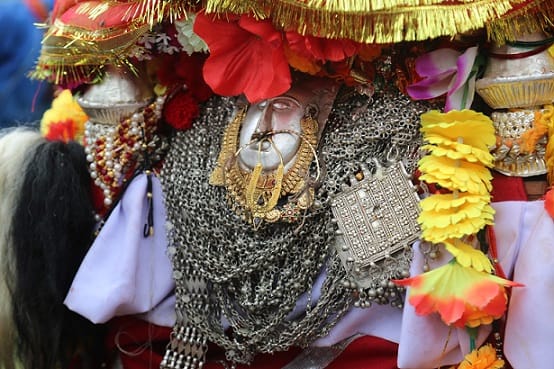
Kurud’s Ma Nanda Devi Doli
Picture By – Mr. Kuldeep Bangari
The annual Jat starts from Kurud and goes till Balpata. In this yatra, both Dolis travel through their villages and reach Balpata via Wan. On the return, Badan’s Doli goes to Devrada, and for the next 6 months, the Badan Doli is worshipped at Nanda Devi temple in Devrada. Dasoli’s Doli comes back to Kurud. This annual Jat is also called Chhoti Jat or Kaisin Jat.
The 12-year Jat is called Badi Jat or Thulli Jat. It also starts from Kurud, and just like the annual Jat, it passes through many villages, but this one is bigger. Many more Dolis and Chantolis join it from nearby villages. This Jat does not end at Balpata but at Homkund. All rituals in Kurud temple are done by Gaur Brahmins.
Now let’s talk about Nauti’s Nanda Devi Raj Jat. This is the same yatra that most people know as the main Nanda Devi Raj Jat. It was started by the Kunwars of Kansuwa. The Nautiyals of Nauti are their Kul Purohits. In Nauti, a sacred Shri Yantra of Maa Nanda is established. It was placed by King Raja Kanakpal, the ancestor of Kansuwa Kunwars. This is the same yatra that we read in detail above.
Now let’s come to the real controversy.
The dispute began when the government started giving more promotions to Nauti’s Raj Jat. In the 2000 and 2014 Nanda Devi Raj Jat Yatra, the government gave funding and facilities only to Nauti’s Raj Jat. Because of this, the people of Kurud and Nandanagar felt ignored. They started raising their voice through different platforms.
Recently, the Kurud Nanda Jat organizing committee even wrote a letter to Chief Minister Pushkar Singh Dhami. They requested that Kurud Siddh Peeth should also be declared as a starting point of Nanda Jat. They also said that Kurud should be shown on the Uttarakhand map as an important point of Nanda Jat.
Some people also say that this conflict has roots in the old tradition of Bali (animal sacrifice). In Nauti, this tradition is now completely stopped. But in Kurud, some say this tradition still happens in some form. This also became one reason for disagreement.
Actually, this is not a fight between two places. It is more like an emotional issue of pride and recognition. Both Nauti and Kurud have their own history, rituals, and deep faith in people. Both deserve respect and honour.
From where Nanda Devi Raj Jat Yatra 2026 will start?
The official starting point of Nanda Devi Raj Jat Yatra is considered Nauti village. But when we see the detailed tradition and history, this sacred yatra actually starts from Kansuwa village.
Only the royal Kunwar family of Kansuwa village has the right to start this yatra. The Nautiyal family of Nauti village are the royal priests (kul purohit) of the Kunwars. So, the yatra’s rituals and start are decided only by the Kunwars, and Nautiyals perform the priestly duties during the yatra.
It is believed that Ma Nanda herself gives different signs to the Kunwars of Kansuwa when she wishes to visit her Maith. These signs can come in many ways — like coming in their dreams, or the birth of a four-horned ram (chaun singh wala mendh), or some other spiritual signs. When the Kunwars feel sure that Nanda Devi wants to go on Raj Jat, they call their royal priests, the Nautiyals. After this, the preparations for Nanda Devi Raj Jat Yatra 2026 begin. Kunwars prepare and decorate chatoli and Chyosingya Khadu and bring them to Nauti village on the day of Krishna Janmastami.
Earlier, these Kunwars were the rulers of Chandpur Garh, so this responsibility of starting the yatra is with their family from old times.
As per the tradition, the Nanda Devi Raj Jat Yatra 2026 will first start from Kansuwa village. On the next day it will come to Nauti village. Then the next day it will go to Era Badani, and the day after that return to Nauti village On the next day it will again go back to Kansuwa village.
After this ritual circle, the main journey of Nanda Devi Raj Jat Yatra 2026 will move ahead towards the Himalaya. (Detailed itinerary is given in this article)
Has Chiyoshingya Khadu arrived in the world?
In the traditions of Nanda Devi Raj Jat Yatra 2026, a very important role is played by the Chiyoshingya Khadu — the special four-horned ram. This sacred ram is also called Devrath of Ma Nanda. From the beginning till Homkund, it walks in the front and leads the whole yatra. After reaching Homkund, it leaves the group and goes alone towards Kailash, symbolically taking Ma Nanda to her divine husband Lord Shiva.
This Chiyoshingya Khadu is not just an animal in the eyes of the devotees — it is seen as a divine messenger of Ma Nanda. People believe that when this rare ram takes birth, it is a sign that Ma Nanda has decided to go on her Raj Jat Yatra. So, the birth of this ram is considered a very spiritual and emotional moment.
Recently, news came that a four-horned ram has been born in Koti village at the home of Harish Lal. Because of this, people are discussing whether this ram will be accepted as the Chiyoshingya Khadu of Nanda Devi Raj Jat Yatra 2026.
But till now, the Nanda Devi Raj Jat Samiti has not officially accepted this ram as the Devrath. The committee has clearly said that no final decision has been taken about the Chiyoshingya Khadu yet.
The Samiti said that after the final selection of the Khadu, a special ritual called Modwi Puja will be performed. Only after this, the official Panchang of Nanda Devi Raj Jat Yatra 2026 will be released. This Panchang will have all the details and schedule of the yatra.
As per the tradition, this Panchang will be released on 23 January 2026( Basant Panchami of the coming year). Until then, there is no confirmation about the Chiyoshingya Khadu.
How will the auspicious time for Nanda Devi Raj Jat Yatra be calculated?
In the Nanda Devi Raj Jat Yatra, deciding when the yatra will happen is a big and sacred process. We already discussed earlier how the main decision is taken on whether the time for the Raj Jat has come or not. But once it is decided that the yatra will happen, then the next important thing is to find the exact dates.
The organisers have to decide on which day the yatra will start, when it will reach each main village, when it will reach Bedini Bugyal, and when it will reach Homkund. For this, special traditional rules and rituals are followed. Many factors are considered carefully.
This work is done at the Siddh Peeth Nauti temple on the day of Basant Panchami. The next Basant Panchami will be on 23 January 2026. On that day, the Kunwar from Kansuwa village will go to Nauti temple. The Nautiyal family, who are the royal priests (Rajpurohit) of Nauti, will calculate and announce the Muhurat (auspicious timing) of the yatra.
While deciding the Muhurat, they keep many things in mind. Some main points are:
- They see the zodiac sign (Rashi) of Goddess Nanda, which is Vrischik (Scorpio).
- They also see her Nakshatra, which is Anuradha Nakshatra.
- They match these positions with the current zodiac sign of the Raja (at present, one of the Kunwar from Kansuwa).
- Another very important point is that the yatra has to reach Kulsari village on the day of Amavasya for the special Kali Puja.
It is also considered that on Saptami Jat should be at Bedini Bugyal, on Astami Jat should be at Silasamudra and on Nawami Jat should be at Homkund.
After checking all these things, the final Muhurat of the yatra is decided.
So, the auspicious time (Muhurat) for the 2026 Nanda Devi Raj Jat Yatra will be calculated and announced on Basant Panchami, which is on 23 January 2026.
All Halt Places of Nanda Devi Raj Jat Yatra 2026
The Nanda Devi Raj Jat Yatra is a long and sacred journey. It passes through many villages, meadows, and high-altitude places before reaching Homkund. Every halt (stop) of this yatra has a special story and belief connected with it. Let’s know about the main halts of the 2026 Raj Jat Yatra.
Halt 1 – Nauti Village
The yatra starts from Nauti village. On the day of Krishna Janmashtami, the Kunwar from Kansuwa village come here along with the Chatoli (sacred wooden structure) from Kansuwa and Chyosingya Khadu. They visit their Kul Purohits (family priests) in Nauti.
Here, the Chatoli is given life through a Pran Pratishtha ritual. In the Nanda Devi Siddh Peeth temple of Nauti, there is an ancient Shri Yantra. It is taken out only on this day for worship. Normally, this Shri Yantra always stays hidden, and no temple can be built in its place.
It is believed that Raja Kanakpal had established this Shri Yantra at the main square of Nauti village.
Halt 2 – Era Badani
Era Badani is around 22 km from Nauti. It is at an altitude of 1240 metres. This is the same place where Jaman Singh Jadora had once requested Goddess Nanda Devi that whenever she goes towards Kailash, she must visit their village.
Since then, every Raj Jat first goes to Era Badani. This is the first stop after leaving Nauti.
Halt 3 – Nauti (via Villages)
After worship at Era Badani, the yatra returns to Nauti. It comes via Rithili Jakh, Diyarkot, Kukre, Puriyali, Kanot, Jhurkande, and Naini villages.
On this day, a special puja is also done at the Seleswar temple in Nauti.
Halt 4 – Kansuwa (10 km, 1530 m)
The yatra now moves towards Kansuwa village. It is about 10 km away from Nauti at an altitude of 1530 metres.
This is the native village of the Kunwar family who are considered the present-day heirs of the royal family of this tradition.
Halt 5 – Sem (10 km, 1530 m)
From Kansuwa, the yatra goes to Sem village. It passes through Mahadev Ghat, Chandpur Ghar, and Ujjwalpur.
In Sem, the Dyoudi Brahmins perform puja of Goddess Nanda at the Mahadev temple. Chandpur Ghar was once the first capital of the Garhwal kings.
Halt 6 – Koti (10 km, 1630 m)
From Sem, the yatra moves to Koti village via Dharkot, Ghandiyal Dhar, Banoili, and Benital.
Here, the Chatoliya (bearers of the sacred Chatoli) from Khandura, Rathura, Chulakot, and Thapli villages join the main yatra. The Chatoliya of Bangali Latu Devta, Kedaru Devta, and Chula Ghathora also join here.
In the old royal time, Koti village was the main base camp of the king’s army.
Halt 7 – Bhagoti (12 km, 1500 m)
Bhagoti is about 12 km from Koti and lies at an altitude of 1500 metres. This is the last village of Nanda’s “Maika” (maternal side). Just below this village flows the Kyul Gadera stream, which marks the boundary between Nanda’s Maika and Sasural side.
This halt is very emotional for the devotees because it is believed that from here, Nanda starts her journey from her Maika towards her Sasural side.
Halt 8 – Kulsari (12 km, 1050 m)
Kulsari is the first village of the Sasural region. It is located on the banks of the Pindar river. The yatra reaches here via Kewar, Narayanbagar, Meeng, and Harmani.
At night, the Kal Ratri is held here. On this night, the Kali Yatra is taken out and special puja is performed. This ritual can be done only on Amavasya night, so the yatra is scheduled in such a way that it reaches here exactly on Amavasya.
Halt 9 – Chepdo (10 km, 1165 m)
After Kulsari, the yatra goes to Chepdo village. The Butola Vanshaj (descendants of the Butola clan) live here. They take part in the rituals and welcome the yatris.
Halt 10 – Nandkesari (5 km, 1200 m)
From Chepdo, the yatra moves to Nandkesari via Vijaypur, Sera, Budjoula, Kalyani, and Chindiya villages.
In the year 2000, after 75 years, the Doli from Kumaon joined the Raj Jat at this very place. Here, the Kurud village’s Badan Doli also joins the main yatra.
I have written a detailed article on Nandkesari. You can read it here.
Halt 11 – Faldiya (10 km, 1480 m)
The yatra then goes to Faldiya village via Purna, Hat, Kalyani, Deval, and Unangra.
Even today, the wheat crop never grows in the Purna village. Locals believe that this is due to a curse given by the Goddess long ago. This belief is still strong among the villagers.
Halt 12 – Mundoli (10 km, 1750 m)
From Faldiya, the yatra goes to Mundoli via Kande, Pilkhada, Lwani, and Bagri Gad. Just opposite Lwani is Malla village, which is the birthplace of Devta Dyosigh.
Mundoli also has an ancient temple and it becomes full of pilgrims during the yatra days.
Halt 13 – Wan (15 km, 2450 m)
From Mundoli, the yatra reaches Wan village via Lohajang.
This is the last permanent village on the route. Wan has an ancient Latu Devta temple. From here onwards, no musical instruments are allowed to be taken further in the yatra.
At Wan, many other dolis and chatolis join the main yatra like the Kurud’s Dasoli Doli, Painkhanda Doli, and many more.
Halt 14 – Gairoli Patal (10 km, 3032 m)
From Wan, the yatra climbs up to Gairoli Patal via Rankidhar, Danigwat, Dadimadali, and Joula Mangra.
It is believed that Goddess Nanda killed the demon Ranksur at Rankidhar, that’s why this place got this name. Below Rankidhar, on the banks of the Nilganga river, the Kunwar family performs tarpan (ritual offerings) for their ancestors.
After that, the yatra reaches Gairoli Patal, which is the first resting place in the middle of nature. Some yatris stay here at night for rest before moving ahead to higher meadows.
Halt 15 – Patar Nachoniya (12 km, 3650 m)
After Gairoli Patal comes the beautiful Bedini or Baitrni Bugyal, where there is also a sacred kund. It is believed that Ma Bhagwati killed Mahishasur here. The yatra reaches this place on Saptami.
There are two ancient temples here — one of Mahishasurmardini and another of Ma Nanda Devi.
At this place, the Painkhanda Doli ends its journey and returns. The Raj Kunwar performs tarpan for his ancestors with Kuniyal Brahmins here.
This place was earlier known as Niralidhar. But when King Jasdhaval came here with his pregnant queen and made his dancers (nachiniyan) dance on the flat rocks, those dancers turned into stones. Since then, this place has been called Patar Nachoniya.
Halt 16 – Silasamudra (15 km, 4210 m)
Around 4 km ahead of Patar Nachoniya is Keluw Vinayak, from where Kaluwa river originates. That’s why it is called Kaluw Vinayak. There is also an ancient idol of Lord Ganesha here. From this point, the Dyosigh Devta of Sutol becomes the path guide of the yatra.
Around 7 km from Patar Nachoniya is Baguwa Wasa, where people believe that Ma Bhagwati’s vahan (vehicle), Bagh, used to rest.
From here the route goes through Chediya Nag, Roopkund, Jyura Gali, and Thala Holari to reach Silasamudra.
About Roopkund, it is said that when Ma Nanda felt thirsty here, Lord Shiva pierced the earth with his trident, creating a pond. When Ma Nanda saw her reflection in that pond, it was named Roopkund.
The yatra reaches Silsamudra on Ashtami. There is an ancient Bhagwati temple here. From Silasamudra, the sacred Roopganga river originates.
Halt 17 – Chandniya Ghat (16 km, 4010 m)
After Silasamudra, the yatra goes through Thopiya and finally reaches Homkund. The yatra arrives here on Navami.
At Homkund, the Nav Durgas are worshipped. All these pujas are performed by the Kuniyal Brahmins.
From here, the Chiyoshingya Khadu is released towards Mount Kailash. He disappears on the way while going towards Kailash, and from this point onward, he is never seen again. This marks the symbolic departure of Ma Nanda as Devrath towards her in-laws’ home (Kailash).
For night stay jat comes to Chandniya ghat.
Halt 18 – Sutol (18 km, 2192 m)
Sutol village lies at the confluence of Roopganga and Nandakini rivers.
Just above the village, at a place called Thatra, there is the ancient temple of Devta Dyosigh.
From here, the pilgrims take different return routes.
- Painkhanda side devotees go towards Kanol.
- Some go towards Wan village.
- The rest of the devotees go towards Ghat.
Halt 19 – Ghat (25 km, 1331 m)
After Sutol, the yatra comes down to Ghat town. This is the last major market halt in the yatra route before heading back to Nauti. Many pilgrims end their journey here and head towards their homes.
Halt 20 – Nauti (60 km)
Finally, the grand Nanda Devi Raj Jat Yatra returns to its starting point — Nauti village.
Here the yatra comes to an end.
A special Shreemad Bhagwat Katha is organised at this occasion, and on this same day, the Bhagwat concludes.
Prasad is distributed among all the devotees, and after that, all the pilgrims and the Kunwars of Kansuwa return to their own villages.
With this, the centuries-old Nanda Devi Raj Jat Yatra concludes with divine blessings and emotional farewells.
What Difference Will Be in Maiti Side Chantolis and Sasural Side Chantolis
In Nanda Devi Raj Jat Yatra, chantolis play a very sacred role. They are like symbolic palanquins of Ma Nanda. Kunwars of Kansuwa prepare the very first chantoli. They decorate them beautifully and then take them to Nauti village for pran pratishtha. These chantolis are made from ringal (bamboo). On them, small cloth bundles called manoti are tied. Manoti bundles are vows taken by the Kunwars for successfully organising the whole yatra as per the rules and rituals. But there is a clear difference between the chantolis of maika side (maternal side) and sasural side (in-law side) of Ma Nanda.
The area before Kyul Gadera is known as the Maika side of Ma Nanda. Chantolis from this side are square in shape, bright and colourful. They are decorated with shiny silk cloths and colourful threads. The area after Kyul Gadera is called the Sasural side of Ma Nanda. Chantolis from this side are round in shape and made from bhojpatra (birch bark). They look simple and traditional. All chantolis are carried barefoot, following strict rituals.
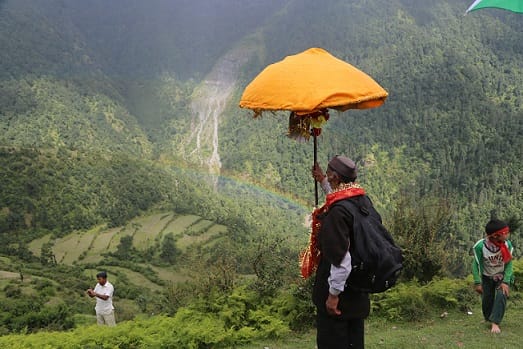
A Chanotholi From Souryas Chetra
Picture By – Mr. Kuldeep Bangari
This difference shows the change from Ma Nanda’s maika to her sasural, and adds a special traditional meaning to the sacred yatra.
Importance of Kulsari, Shri Yantra and Kal Ratra in Nanda Devi Raj Jat Yatra
Kulsari is known as the first stop of the Sasural route in the Nanda Devi Raj Jat Yatra. This place holds a small but very sacred Kali temple. People here believe that Maa Kali is also a form of Maa Dharti and they also see her as the sister of Maa Nanda.
The yatra reaches Kulsari only on the day of Jat Amavasya. It is because the special Kali Yantra is taken out from the temple only on this day. Local belief says that Maa Kali meets her sister Maa Nanda only after doing this ritual.
Earlier, there was also a tradition of animal sacrifice on this occasion. But now it has stopped. Now, the rituals are done by cutting rot (chapati made in ghee) instead of sacrifice.
This Kali Yantra is taken out from the temple only on this one day in the whole year, which makes it very rare and powerful.
Where Kumaon Side Dolis and Chatolis will Join Garhwali Dholis in Nanda Devi Raj Jat 2026?
The Kumaon side Dolis and Chatolis come from many places like Almora, Nainital, Bageshwar and other nearby regions. These Dolis travel a long way to join the main Nanda Devi Raj Jat Yatra.
They all meet with the Garhwali Dolis at Nandkesari. This is the main point where Kumaon Dolis and Garhwal Dolis come together and continue the sacred journey as one group.
Along with these Kumaon Dolis, the famous Badan Doli from Kurud village also joins the Yatra at this same place.
Where Dasoli, Dasamdwar and Painkhanda Dolis and Chatolis will Join the Nanda Devi Raj Jat Yatra 2026?
The Dasoli Doli starts from the Siddh Peeth Kurud. From there, it travels around the Dasoli Patti area and reaches Kanol village.
In the same way, the Painkhanda Doli starts from Lata village. It moves through the Painkhanda and Jotirmath region and also reaches Kanol.
These two Dolis join together at Kanol. From Kanol, they move ahead towards Wan village. The Chatolis from their areas also go along with them. At Wan, they all become part of the main Raj Jat Yatra.
The Dasamdwar Doli starts from Dasamdwar and directly goes towards Wan. It also joins the Raj Jat at Wan.
In this way, more than 200 Devi-Devtas and over 100 Dolis and Chatolis gather at Wan. A huge crowd of devotees also comes here to witness this grand moment.
What Will Be the Return Route of Nanda Devi Raj Jat Yatra 2026?
On Navami, the Nanda Devi Raj Jat will reach Homkund. After doing the puja and bidding farewell to Maa Nanda, the yatra will move the same day towards Chandniya Ghat. Chandniya Ghat is said to be the place where one of Maa Nanda’s Gan stayed, so this place is named after him.
The next day, the yatra will reach Sutol village. This village is also known as the last village of India in this region. The local deity here is Bhumiyal Dyosingh. From Sutol, the devotees of Painkhanda region will go towards Kanol. The villagers from Wan side will return towards Wan. The main Nauti yatra will move towards Ghat.
After that, the yatra will reach Ghat, where the devotees from Kurud will go back towards Kurud.
On the next day, the main yatra will move from Ghat via Nandprayag and reach Nauti. At Nauti, the Raj Jat will end with rituals and ceremonies.
This return route is completely different from the onward journey. The return route of Nanda Devi Raj Jat goes through the Ghat valley side.
Legend Behind Roopkund
According to local folklore, King Jasdhaval of Kannauj was traveling to Nanda Devi Raj Jat with his queen, servants, and dancers. The group disrespected the sacred land by singing and dancing, angering the goddess. As a result, a massive hailstorm struck, killing the entire group. Their skeletons remain preserved in Roopkund Lake to this day.
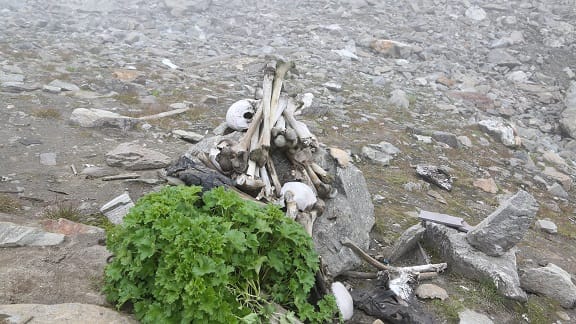
Remaining Skeleton in Roopkund
Picture By – Mr. Kuldeep Bangari
Scientists have also studied these skeletons and found that they belong to different periods, some as old as 1200 years. However, the exact reason for their presence remains a mystery.
Nanda Devi Raj Jat Yatra 2026 Registration and Online Booking
Till now, the government has not opened any registration window for Nanda Devi Raj Jat 2026. In the 2014 Raj Jat also, there was no registration process. But this time, the government may open registration counters like Char Dham Yatra. In one way, this will be helpful. It will make it easy to manage such a big yatra in future. It will also help in keeping all devotees safe.
Some historians, environmentalists, and nature experts say that after Wan, only selected and limited people should be allowed in the yatra. It will help to stop pollution in the bugyals. It will also protect the local wildlife and natural biodiversity from the side effects of heavy crowds.
If you also want to join Nanda Devi Raj Jat 2026, you can come with us. We will start trekking services for Raj Jat 2026 with Auli Skiing School. Auli skiing School is a skiing and trekking service provider in Chamoli district. For any details or Nanda devi Raj Jat yatra 2026 bookings, you can email us at auliskiingschool@gmail.com.
Tips for Nanda Devi Raj Jat Yatra 2026
Nanda Devi Raj Jat is a long and tough yatra. It goes through high-altitude Himalayan routes. So, you must be well prepared. Here are some useful tips:
1. Health Preparation
Before joining the yatra, get a full body check-up. Start light walking and jogging a few weeks before. Do some breathing exercises also. Carry your regular medicines and a small first-aid kit.
High altitude can cause breathing problems. So, move slowly, drink water, and take rest whenever needed.
2. ID Card and Permissions
Always keep your government ID card like Aadhaar or voter ID with you. It may be needed at check points or camps.
If the government starts registration for the yatra, do it on time and carry the registration slip.
3. Responsible Travel
Respect local culture, temples and deities. Do not throw plastic or waste in the bugyals or on the route. Carry your waste back.
Avoid loud music and noise. Remember, this is a spiritual yatra, not a picnic.
Do not harm any wild animal or plant on the way.
4. Clothing and Gear
Carry warm clothes, raincoat, trekking shoes, torch, and a strong backpack. Weather can change anytime in the Himalaya.
Use good quality shoes because the path can be slippery and rocky.
5. Travel Insurance and Money
Keep some cash with you because the network and ATM are not available in many remote areas.
If possible, take a basic travel insurance.
6. Group Travel
Travel with a trusted group or guide. Never walk alone in unknown patches.
Stay with the yatra group and follow the timings given by the organisers.
FAQs – Nanda Devi Raj Jat Yatra 2026
Q1. How often does the Nanda Devi Raj Jat Yatra happen?
This yatra happens every 12 years. The last yatra was in 2014 and the next will be in 2026.
Q2. How long is the Nanda Devi Raj Jat Yatra route?
The yatra route is around 280+ kilometres and it takes around 22-23 days.
Q3. From where the main yatra will start?
The main yatra starts from Nauti village near Karnprayag in Chamoli district, Uttarakhand.
Q4. Is any registration needed to join the yatra?
Till now, no official registration system has been announced. But the government may open counters like Char Dham. So keep checking updates.
Q5. Can old people or children join the full yatra?
The route is very tough and goes above 5000 metres. So it is not safe for small children, very old people or anyone with health issues.
Q6. What is the best way to prepare for this yatra?
Start fitness training early. Practice walking long distances. Keep warm clothes and good shoes. Go with a guide or in a group.
Q7. How will network and mobile connectivity be during the yatra?
After Wan village, the network becomes very weak or not available. So inform your family before going and stay with your group.
Q8. Is food and water available on the way?
Yes, many local people and groups set up langars and tea stalls. But carry dry snacks, glucose, and a water bottle always.
Conclusion
Nanda Devi Raj Jat Yatra is not just a pilgrimage. It is a centuries-old tradition full of faith, culture, and devotion. This journey passes through deep forests, high bugyals, and sacred Himalayan peaks. Thousands of devotees walk together with full faith and respect for Maa Nanda.
If you are planning to join the Nanda Devi Raj Jat Yatra 2026, prepare your body and mind both. Travel with discipline and follow all local rules. Respect the culture, protect the environment, and support the local people.
This sacred yatra is a chance to feel the real spiritual power of the Himalaya. Once in your life, you must experience the divine energy of Maa Nanda Devi Raj Jat Yatra.
– By Mohit Bangari
Written On- 17 February 2025
Updated On- 14 September 2025
Also Read
You can also explore more on Himalayan treks like Darma Valley, Adi Kailash, and others on my website mohitbangari.com, where I share full guides, routes, permit tips and cultural info.
Do you know about Ramman festival of Salud-Dungra village? It’s one of the intangible world cultural heritage of India in UNESCO. You can read a detailed article on this topic here.


Explore the beauty and cultures of the Himalayas, from Jammu and Kashmir to Arunachal Pradesh, Tibet and Nepal. My blog shares stories, pictures, and fun articles about this amazing region. Come along on a journey where each mountain has a tale and every valley hides a treasure. Join me as I discover the magic of the mountains together.
Welcome to my Himalayan Adventure!

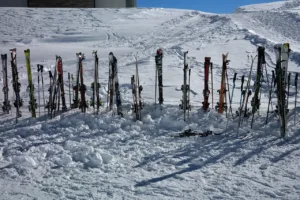

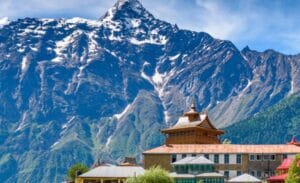
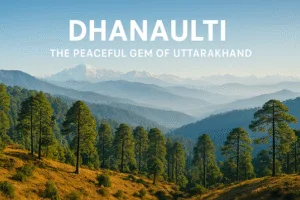
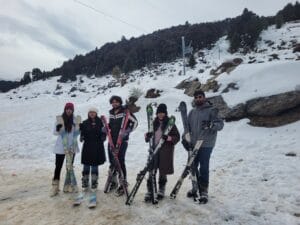
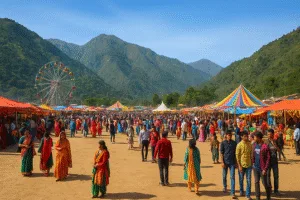
1 thought on “Nanda Devi Raj Jat Yatra 2026 – A Sacred Himalayan Pilgrimage”
Pingback: Latu Devta Temple (Chamoli): The Watchful Guardian of Nanda Devi at Wan - mohitbangari.com